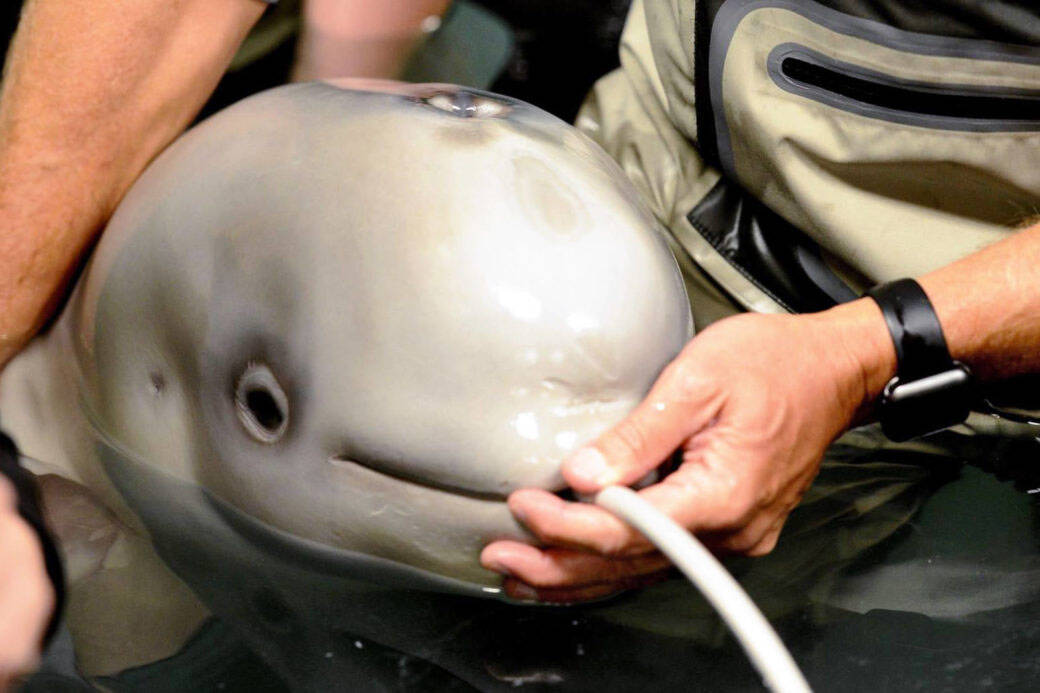The journey of two beluga whales brought to the Alaska SeaLife Center in Seward for rehabilitation is the subject of a new study published last month in the scientific journal Polar Research. Both whales were found stranded and transported to the center, where they underwent treatment. While only one of the whales survived, researchers say the cases offer new insights into the animals.
“Once thought to be close to impossible, these cases demonstrate the ability to care for and, in DL1705’s case, rehabilitate stranded beluga calves, providing another tool to assist in the conservation of endangered populations,” the paper’s conclusion says.
Among the authors were four scientists with the center — Caroline E.C. Goertz, Kathy Woodie, Brett Long and Lisa Hartman. Other organizations represented by the paper’s authors include the Alaska Fisheries Science Center’s Marine Mammal Laboratory, the Cooperative Institute for Climate, Ocean & Ecosystem Studies and the Marine Mammal Health and Stranding Response Program.
The study followed two beluga calves: one, Naknek, rescued from Bristol Bay after it was stranded by severe storms in 2012 and one, Tyonek, rescued from Cook Inlet in 2017. Both were taken to and treated at the Alaska SeaLife Center in Seward. In-pool flotation support, close monitoring of respirations and behavior and gastrointestinal support were among the ways calves were treated at the center.
“Aspects and details from successful cases of cetacean critical care become important references especially vital for the survival of essential animals in small, endangered populations,” the paper’s abstract says.
Naknek died after three weeks of supportive care, while Tyonek recovered — he is the first beluga calf in the world to be successfully rehabilitated, according to the SeaLife Center. Still, Tyonek was declared non-releasable and put in long-term care at a zoological facility to live with other beluga whales, the paper says.
“Working with Tyonek, from day one to date, made visible the strength, powerful contribution and impact that comes from collaboration within the zoological community,” said Steve Aibel, who helped care for Tyonek, in a release from the SeaLife Center. “This was one of many instances where animal care experts, veterinarians, and research scientists from multiple organizations came together with a singular goal of helping a little whale in need.”
It’s difficult to rehabilitate beluga whales. Between 1977 and 2002, 60 out of 70 cetaceans stranded alive in California ultimately died — about 86%. A similar survey of data collected between 2000 and 2016 showed that 294 of 396 rescued cetaceans — about 74% — died or were euthanized.
Following an intake exam, Naknek was determined to be about 2 days old. He had an “initially uncoordinated” swim pattern, but eventually began to swim in smooth arcs. Later swim patterns suggested he was experiencing abdominal pain and a few weeks later he “succumbed to sepsis secondary to a possible prematurity-related lack of passive transfer of antibodies.”
In contrast, Tyonek, who was examined in September 2017, was determined to be just over 2 weeks old. Tyonek had similar — albeit less severe — gastrointestinal problems and was still able to hear a wide range of frequencies. Tyonek was determined to be nonreleasable because of his inability to survive on his own, but moved to SeaWorld San Antonio in 2018, where he is part of a pod of whales.
Sicknesses in both whales were tied to the “trauma” of being stranded. Among other things, the beach’s hard surface can make it difficult to inhale causing poor ventilation and carbon dioxide buildup and the orientation of the animal may cause water to enter their blowhole.
One of the challenges of rehabilitating belugas is their habitat, which is typically remote and rugged and makes it difficult to find and coordinate rescue efforts. This poses a unique threat to Cook Inlet’s beluga whales, which are considered endangered. A 2018 estimate puts the total number of beluga whales in Cook Inlet at 279 and declining.
“Every individual is essential to the population,” the paper says.
According to the Alaska SeaLife Center, Cook Inlet’s population of beluga whales is the most isolated, with some genetic samples indicating that they have been isolated for “several thousand years.” The inlet’s beluga population was estimated to be around 1,300 in the late 1970s.
The Bristol Bay beluga faced its greatest challenges, the paper concluded, from its young age, lack of time spent with its mom and “apparent immaturity.” In contrast, the Cook Inlet beluga whale, who was able to bottle feed after being rescued, likely had a familiarity nursing. That acceptance of a bottle prevented the need for tube feeding.
“Finally, the experiences of the first case and the depth of the expertise of the team made it possible to identify and mitigate problems early,” the paper concluded.
The full article can be read at polarresearch.net.
Reach reporter Ashlyn O’Hara at ashlyn.ohara@peninsulaclarion.com.

